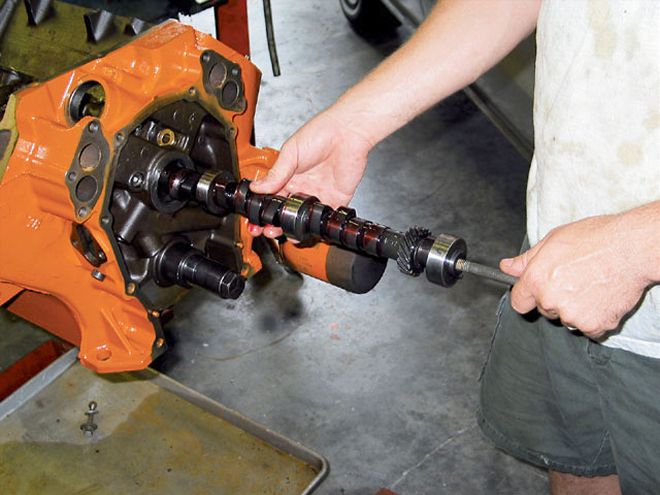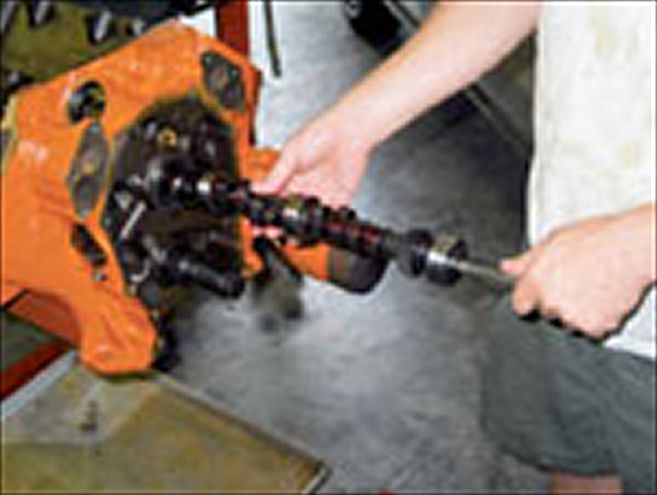


Whether you're an experienced engine builder or a weekend cruiser, you've probably heard the term "camshaft degreeing." To most, it brings visions of expensive precision equipment, complicated mathematical formulas, and lots of time. Contrary to popular belief, however, an advanced degree is not required when it comes to the timing of your camshaft. When broken down into simple steps, camshaft degreeing is as easy as setting valve lash, and takes about as much time. The tools you will use are probably in your box already, and if not, they are easily attainable and not very expensive. This article will detail the reason for camshaft degreeing, as well as take you through the steps to properly degree your camshaft.
The one and only reason to degree a camshaft is to ensure that it is properly phased (timed) with the crankshaft. It is really that simple. Keep in mind, that by degreeing the camshaft we are not changing the camshaft centerlines or timing, we are simply making sure that when installed, the cam's relationship with the crank is as the manufacturer intended. We have all heard that by advancing or retarding the cam timing, an engine will make more power or torque at a certain rpm. We have seen this method used with varying degrees of success, and in our opinion, if it is necessary to change your cam timing to achieve your goal, your application probably needs a different camshaft (the exception being certain stock racing classes). Companies such as Comp Cams have hundreds of camshafts to meet virtually every application and will custom grind a cam to meet your needs, changing the specs and centerlines if necessary. Our purpose is to give details on degreeing the cam, only changing the cam timing to the extent necessary to correct improper phasing.
In a perfect world we would not have to check camshaft-to-crankshaft phasing because all of our components would be manufactured accurately. This, however, is not a perfect world, and many factors can cause improper camshaft phasing. Improper cam or crankshaft machining, misindexed keyways or dowel pins, improper timing gear markings, or an accumulation of machining tolerances are the leading causes of improper camshaft phasing. It is usually not the camshaft itself, but the way the other engine components are manufactured or machined that necessitates degreeing the cam.
The following instructions will allow you not only to check your camshaft timing, but also to correct it if it is not right. Of the several accepted methods to properly degree a camshaft, we will outline the intake centerline method, as it is the easiest to understand. While this procedure can be accomplished with the engine in the car, the best time to degree the cam is during engine assembly. For our example, we will be installing a Comp Cams (PN 21-231-4) solid flat-tappet camshaft, lifter, and spring kit into a '68 440 HP, which is destined for our '68 GTX clone. The procedure is the same, whether you are working on small-blocks or Hemi engines.
Aside from basic hand tools, you'll need a few specialty items. Most of these are common if you assemble your own engines, and will complement your toolbox if you don't. First, you'll need a degree wheel and a pointer (the pointer can be made with coat hanger wire or the end of a scribe, as we used). The degree wheel is basically a round piece of sheetmetal with the 360 degrees of a circle printed on it. This, along with a pointer, tells us where the crankshaft is during its rotation. Next is a dial indicator with a magnetic or mechanical base to keep it stationary (be sure your dial indicator has sufficient travel to accommodate your cam's lift). A top-dead-center piston stop needs to be used if the heads are already installed. If not, you can use the dial indicator on the piston to determine top-dead-center before installing the head. If your combination utilizes hydraulic lifters (ours doesn't), you'll need a solid lifter that fits your engine. Also, an adjustable pushrod length checker (we made ours from an old pushrod) is used in engines that don't have adjustable rocker arms (ours are adjustable). Comp Cams has a degreeing kit available, which includes all of the necessary tools with the exception of the solid lifter and the pushrod length checker.
Note
If your heads are already installed, you can still find true TDC by using a positive piston stop threaded in the number one spark plug hole. Be sure the piston is below TDC and install the stop, now rotate the crankshaft counter clockwise, then clockwise noting the degrees on the degree wheel in both directions at the stop. Half of the number of degrees between stops is TDC. With the stop removed, rotate the crankshaft half of the amount of degrees noted (either forward or backward depending on where you stopped) and reset the pointer to true TDC.
In our example, the intake centerline was supposed to be 106 degrees and it was. While this is good news in terms of engine assembly, it's not so great for this article since one of our goals is to show how to correct for an improperly phased camshaft. We'll now give an example of the camshaft timing being off so that we can show how to correct it.
Let's say that we completed the steps above and that our numbers at .050 were 78 degrees and 130 degrees. When added and divided by two, the resultant is 104 degrees. Since the cam card calls for a 106-degree intake centerline, we will need to change the camshaft phasing. Since our camshaft is two-degrees advanced in our example, we will need to retard the cam timing by two degrees, meaning that we need the intake centerline, or maximum lift, to happen two degrees of crank rotation later than it actually does. There are several common ways to accomplish this, including the use of a crank gear with multiple keyway reliefs, an offset crank keyway, or an offset bushing in the cam gear itself. Another option is an adjustable timing gear or beltdrive system, but be aware the cost of this method is significantly higher. The most common method is to drill the cam gear oversize and install an offset bushing. Be sure to offset the bushing in the proper direction and always repeat the above steps to check that you made the proper correction. Once the intake centerline is properly corrected, you may permanently install the cam gear and finish the engine assembly.
We hope you find the information in this article helpful, and that you feel more comfortable about how and why camshaft degreeing is performed. It is not rocket science, but it does take some time and calculation. By following this article and using the instructions provided with your camshaft, you should be able to perform the task without trouble. For additional information be sure to visit Comp Cams web site, www.compcams.com, where they offer detailed information on camshaft degreeing, as well as the tools to perform the task.